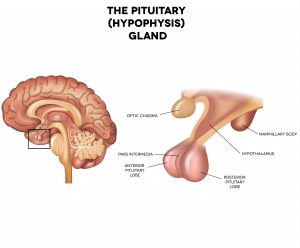 The pituitary gland is often considered the most important part of the endocrine system because it produces hormones that control many functions of other endocrine glands (i.e. hormone producing glands).
The pituitary gland is often considered the most important part of the endocrine system because it produces hormones that control many functions of other endocrine glands (i.e. hormone producing glands).
The pituitary gland is about 5mm in diameter and lies in a bony cavity called the pituitary fossa, behind the bridge of the nose and below the base of the brain, close to the optic nerves. The pituitary gland is made up of two parts:
- The anterior pituitary which is regulated through vascular pathways from the hypothalamus (area of the brain which coordinates the autonomic nervous system and the pituitary gland functions).
- The posterior pituitary which is regulated through neural pathwaysfrom the hypothalamus.
Hormone release from the pituitary gland occurs in one of two ways:
- In response to direct neurological stimulation from the hypothalamus the posterior pituitary gland controls the release of:
- Antidiuretic hormone (ADH) which regulates salt and water balance. In the early post brain injury phase there may be excess or inappropriate ADH release causing low sodium levels (hyponatraemia).
- Oxytocin which stimulates uterine muscle during labour.
- In response to chemicals transported via an intrinsic circulation (portal system) to the anterior pituitary, the anterior pituitary controls the release of:
- Growth hormone (GH) which stimulates growth and development of muscle, bone and fat.
- Adrenocorticotropin (ACTH) which stimulates steroid (cortisol) production.
- Thyroid-stimulating hormone (TSH) which stimulates the thyroid gland necessary for the regulation of body metabolism.
- Luteinizing hormone (LH) which influences sexual functioning through testosterone, oestrogen and progesterone release.
- Follicle-stimulating hormone (FSH) which promotes sperm production in men and ovulation in women.
- Melanocyte stimulating hormone (MSH) which regulates skin tanning in response to sunlight.
- Prolactin which stimulates breast milk production.
Clinical patterns relating to anterior pituitary injury tend not to be evident until several weeks or up to 3 months following injury.